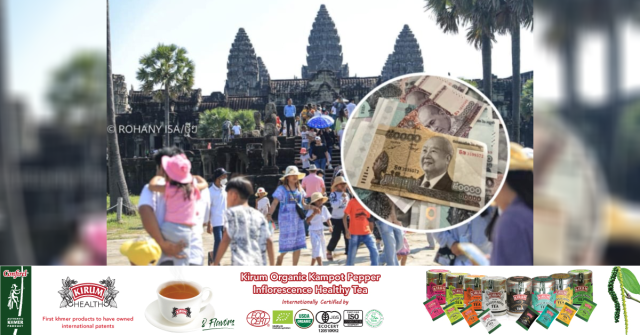Siem Reap Shows Way for Riel Growth

- By Ou Sokmean
- November 3, 2023 2:05 PM
SIEM REAP – For 43 years, the riel currency has made a significant contribution to restoring and rebuilding sovereignty, the economy, and society.
In the early 2000s, the government and the National Bank of Cambodia (NBC) launched a policy to promote the use of the riel after the macroeconomic situation had improved.
The policies, with the participation of stakeholders, have helped to increase its circulation in the market, while the value of riel has stabilized.
Riel currency traffic has increased by an average of 14 percent each year in the last decade, according to a report by NBC. This shows that the demand for the riel has grown in the economy and among the public, though dollarization remains high.

Meas Las, a clothes seller at the Old Market. Photo: Ou Sokmean
The wide use of the riel is an essential contribution to economic development in each province. For example, Siem Reap, a well known tourist province, brings in a lot of foreign currency however, the usage of riel has risen on general expenses such as food, drinks, clothes and travel.
“Most visitors don't usually spend their dollars,” said Man Las, a clothes seller at the Old Market in Siem Reap city for seven years. “They pay me in riel. However, some days, 20 percent of my income is in dollars.”
The use of the riel in Siem Reap increased rapidly after the outbreak of the COVID-19 pandemic, especially after 2020, when the NBC implemented the strategy to collect $1, $2, and $5 banknotes from the market to promote the riel.
At the same time, it launched a campaign to exchange damaged or torn riel banknotes for new ones. It became a catalyst to encourage people in this area to use more riel.
Man Las has noticed that now both Cambodians and foreign tourists carry more riel to spend than ever before. “I am happy to see them spend our Cambodian money. It is better if they only use the riel because it can promote our national currency,” she said.
Tuk-tuk driver Chea Savuth also sees an increase in the circulation of the riel in the Angkor Park area.

Chea Savuth, a Tuk-Tuk driver in Siem Reap. Photo: Ou Sokmean
“Some visitors exchanged money into riel, and when they could not spend it all, they did not take it back! They gave us the remaining money. They keep only the banknotes of 100 riel, 500 riel, and 1,000 riel as a souvenir,” he said.
The use of riel not only makes it easier for locals to pay for products and services, but it also helps to promote the Cambodian nation because it represents the national identity, said Savuth, another tuk-tuk driver in the Angkor area.
“We need to do something to make our riel valuable and make other countries recognize it as popular as the reputation of Angkor Wat Temple,” he said. “We must work on it until all international tourists only spend in the riel when they visit the country.”
Although riel use has expanded recently, tuk-tuk driver Eng Bunlak would like to see more of this currency circulation in Siem Reap.
He mentioned the good practice in Thailand and Vietnam where only their national currencies are used.
“I want it to be like Thailand and Vietnam,” he said.

Eng Bunlak, a Tuk-Tuk driver in Siem Reap. Photo: Ou Sokmean
“Whenever tourists fly into Cambodia, they have to exchange the money for riel to spend. For us, spending riel is useful. It not only boosts the value of the national currency, but it also makes our economy grow.
“For example, if the tourist comes in with the dollar, they exchange it for riel, which will make the bank earn money from exchanging dollars for riel.
“When tourists finish their visit, they will have the remaining riel, which they will exchange for dollars. So, it makes the bank earn again from exchanging money from riel to dollar. This is revenue for our economy.”
Tourism operators see another potential to persuade travelers, particularly foreigners, to use the riel. Duch Sareth, vice president of the Cambodian Tourism Association in Siem Reap, said encouraging tourists to use more riel is not a problem for operators, tour operators, or other businesses as long as NBC or the government has the right policies.
“As long as there is a requirement to buy tour packages or buy tickets in the riel, I believe we can do it, and guests will not refuse to use the riel as well. I believe they will enjoy using it,” he said.
He said the government should be the first to push for the movement and be a role model. The private sector will act accordingly, pointing out that some state institutions still receive revenue in dollars.
For instance, the Angkor Enterprise under the Ministry of Economy and Finance still uses dollar currency to set the price of tickets for foreign tourists to visit Angkor Park. The tickets to Angkor Park cost $37 for one day and $62 for three days, Sareth said.
“Now, if we set the fixed ticket price for Angkor Park in Khmer currency at 150,000 or 170,000 riel per day or more, we should not accept the price in dollars,” he said. “By doing that, foreign tourists will have to exchange dollars for riel.”
Siem Reap is a popular tourist destination in Cambodia because of the famous Angkor Wat and other ancient temples such as Bayon, Phnom Bakheng, Baksei Chamkrong, Baphuon, Banteay Srei and Ta Prohm. At the same time, Siem Reap has been turned into a modern city with the development of hotels, restaurants, and stores to serve the tourism industry.
For the first seven months of 2023, the province received approximately 2.6 million national and international tourists. Among them, 439,365 international tourists bought tickets to visit Angkor Park.

Duch Sareth, Vice President of the Cambodian Tourism Association in Siem Reap. Photo: Isa Rohany
Ly Se, director-general of the Angkor Enterprise, expects that Siem Reap will receive approximately 800,000 international tourists by the end of 2023.
He said about 60 percent of foreign visitors to Angkor have made payments by Visa while 40 percent pay in cash. Of the 40 percent, only eight percent of the payment was in riel. Although the use of the riel for tickets remains low compared with the dollar, the Angkor Enterprise aims to promote the use of the riel in the long run.
“We have a plan to promote the long-term use of the riel currency for customers who come to buy tickets from our Angkor Enterprise,” Ly Se said.
“But we are doing it slowly. The problem facing now is the number of tourists is not yet reaching the number that we want. If we suddenly switch the use of the currency, some tourists might feel uncomfortable and hesitant to visit the park.”
He added that setting the ticket price in dollars is to encourage tourists to stay in the country for a long time, part of tourism recovery after the pandemic.
The Angkor Enterprise will continue to do so until the flow of international tourists to Cambodia stabilizes, as it did in 2019, at which point the ticket price in dollars will be converted to the national currency.
Sok Khon, director of the Department of Statistics and Economic Analysis of the Ministry of Economy and Finance, said that promoting more riel spending would make a greater contribution to economic and social development.
“The riel is a determining factor that contributes to economic and social development,” he said.
Originally written in Khmer for Thmey Thmey, this story was translated by Translate by Chhuon Kongieng for Cambodianess.















